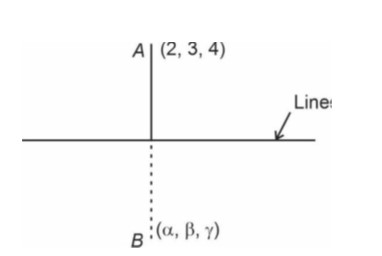If the foot of the perpendicular from point (4, 3, 8) on the line L₁ : (x-a)/l = (y-2)/3 = (z-b)/4, l ≠ 0 is (3, 5, 7) then the shortest distance between the line L₁ and line L₂ : (x-2)/3 = (y-4)/4 = (z-5)/5 is equal to:
If the foot of the perpendicular from point (4, 3, 8) on the line L₁ : (x-a)/l = (y-2)/3 = (z-b)/4, l ≠ 0 is (3, 5, 7) then the shortest distance between the line L₁ and line L₂ : (x-2)/3 = (y-4)/4 = (z-5)/5 is equal to:
Option 1 -
1/2
Option 2 -
1/√6
Option 3 -
2/√3
Option 4 -
1/√3
-
1 Answer
-
Correct Option - 1
Detailed Solution:The shortest distance D between two skew lines is given by the formula:
D = | (a? - a? ) ⋅ (b? x b? )| / |b? x b? |
Line L? : (x-1)/2 = (y-2)/3 = (z-4)/4
Line L? : (x-2)/3 = (y-4)/4 = (z-5)/5Here, a? = I + 2j + 4k, b? = 2i + 3j + 4k
a? = 2i + 4j + 5k, b? = 3i + 4j + 5ka? - a? = I + 2j + k
b? x b? = | I j k |
| 2 3 4 |
| 3 4 5 |
= I (15-16) - j (10-12) + k (8-9) = -i + 2j - kD = | (i + 2j + k) ⋅ (-i + 2j - k)| / √ (-1)² + 2² + (-1)²)
= |-1 + 4 - 1| / √ (1 + 4 + 1)
= 2 / √6
Similar Questions for you
....(1)
Let
Let
Put l1 and l2 in (1)
α = 3
Given , ,
Dot product with on both sides
... (1)
Dot product with on both sides
... (2)
(a – 1) × 2 + (b – 2) × 5 + (g – 3) × 1 = 0
2a + 5b + g – 15 = 0
Also, P lie on line
a + 1 = 2λ
b – 2 = 5λ
g – 4 = λ
2 (2λ – 1) + 5 (5λ + 2) + λ + 4 – 15 = 0
4λ + 25λ + λ – 2 + 10 + 4 – 15 = 0
30λ – 3 = 0
a + b + g = (2λ – 1) + (5λ + 2) + (λ + 4)

Take
x = 2λ + 1, y = 3λ + 2, z = 4λ + 3
= (α − 2)
Now,
(α − 2) ⋅ 2 + (β − 3) ⋅3 + (γ − 4) ⋅ 4 = 0
2α − 4 + 3β − 9 + 4γ −16 = 0
⇒ 2α + 3β + 4γ = 29
Taking an Exam? Selecting a College?
Get authentic answers from experts, students and alumni that you won't find anywhere else
Sign Up on ShikshaOn Shiksha, get access to
- 65k Colleges
- 1.2k Exams
- 679k Reviews
- 1800k Answers
